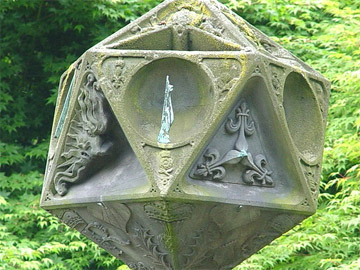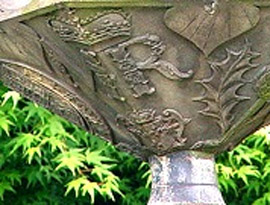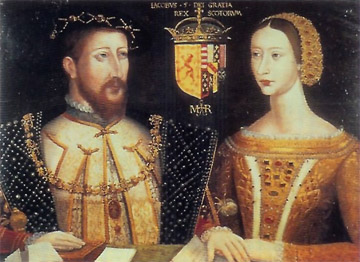By
Tomas Mc Rae, Brisbane, Queensland, Australia, ©2008
[This
article is featured in the Lowlands-L Gallery collection as well.]

 n The
Dwellings of the Philosophers (Les demeures philosophales et le symbolisme hermétique dans ses rapports avec
l’art sacré et l’ésoterisme du grand-oeuvre) the 19th century French occult author Fulcanelli gives a most imaginative description
of a sundial in the grounds of Holyrood Palace attaching all sorts of alchemical
and mystic chivalric symbolism to it. He starts by stating the garden in
which it stands is closed to outsiders then develops his improbable thesis.
Fortunately this garden was since opened to the people.
n The
Dwellings of the Philosophers (Les demeures philosophales et le symbolisme hermétique dans ses rapports avec
l’art sacré et l’ésoterisme du grand-oeuvre) the 19th century French occult author Fulcanelli gives a most imaginative description
of a sundial in the grounds of Holyrood Palace attaching all sorts of alchemical
and mystic chivalric symbolism to it. He starts by stating the garden in
which it stands is closed to outsiders then develops his improbable thesis.
Fortunately this garden was since opened to the people.
I not only saw the object in question during a recent Edinburgh visit but also
took several photographs for subsequent detailed scrutiny. I can safely state
that the much vaunted “Master Alchemist” simply hasn’t got a clue.
This
is the first book of his that I have tried to read and, while in all fairness
the translators may be at fault, I found the language pompous and tedious.
He also does the time honoured trick of wrapping his material in loads of
waffle, something those of us with academic backgrounds are all too familiar
with.
In
fact this chapter, supposedly about a Scottish sundial, is mainly taken up
with irrelevancies and speculations. So what does he claim?
 The
head
of the sundial showing fleurs des lis and the English Rose below a kangaroo-like
co-incidental solar
vane (Photo: Thomas Mc Rae)
The
head
of the sundial showing fleurs des lis and the English Rose below a kangaroo-like
co-incidental solar
vane (Photo: Thomas Mc Rae) |
First
off he states that the structure was built on the orders of King Charles
I in 1633 and the Royal Cipher “CR” (Carolus Rex) is carved on it.
WRONG!
Fact is the cipher is “IR” (Jacobus Rex), and is in line with statements from Palace Staff that the sundial was built
by order of James V, the best patron of architecture in the Stewart Dynasty.
Charles only visited Edinburgh twice and briefly to try and curry favour
with the Scots when the English parliament went against him.
I
admit I was unable to check the other side of the device, I would have been
evicted for violating the lawn had I tried but I am sure on that side we’d find the cipher “MR” (Marie Regina) for Marie de Guise James’s French wife, mother of Mary Queen of Scots.
That
Fulcanelli had never even seen the structure about which he makes such extravagant
claims is evident when he refers to it, via translators as “an extremely unusual little building.” Fact is that with its much later triple pedestal (Built in Queen Victoria’s time) it stands at least nine feet tall.
He
keeps referring to the head portion as some sort of mystical alchemical crystal
yet at the time it was carved fine study of crystals was impossible as the
microscope had yet to be developed to such a level.
I agree
that saturated solutions would have produced masses of large crystals but
doubt they’d be of this type. Scholars of the period were however well acquainted with three
dimensional geometry and this is obviously an example of work by someone
conversant with that science.
Between
vague excursions involving a Scotsman rescuing a Dutch sailor, and telling
us about the Gnomonic influence (?) on this amazing stone he makes the wildest
claims about very obvious historical symbols carved thereon.
For
starters he goes on about the several heraldic thistles carved on lower angles.
Those he tells us are emblematic of The Order of Knights of the Thistle created
in 1540 by James V. He goes on to claim that after its abolition in 1547
it continued as an esoteric Secret Society. If so secret how does he know
this? Fact is the Order was re-constituted by James VI/II in his attempts
to re Romanise Protestant Scotland, he got deposed instead
 The
base of the head showing royal cipher IR (Iacobus Rex) (Photo:
Thomas Mc Rae)
The
base of the head showing royal cipher IR (Iacobus Rex) (Photo:
Thomas Mc Rae) |
In
view of other national symbols on the Head of the sundial it is much more
probable that here the plant is used in its capacity as Scotland’s national emblem.
Fulcanelli
gets so obsessed he next tells us that several depictions of roses are connected
with Nicholas Flamel, they are in fact the emblem of England. And this man
has a following?
Large
carvings of fleurs de lis he claims to be of chivalric significance are actually
to commemorate James’ marriage to his French wife as we can see from other French symbols. The emblems
of Scotland, England, and Ireland appear at the points of an inverted triangle.
This confused me at first but we must recall that James IV married the
sister of Henry VIII of England. His son, because of this marriage considered
himself in line for the English crown in view of Henry’s sibling problems and lack of Papal recognition.
It
is significant that when Mary of Scotland was wife of the French Dauphin
they had the English, Scots, and French arms on their dinner plate signifying
their rights over all three nations.
 James
V of Scotland (1512–1542) and Marie de Guise, Queen consort of Scots,
Duchess of Longueville (1515–1560)
James
V of Scotland (1512–1542) and Marie de Guise, Queen consort of Scots,
Duchess of Longueville (1515–1560) |
Having
seen this gorgeous structure I can state there is not the slightest trace
of any alchemical symbolism or of it being, as Fulcanelli claims an Hermetic
Clock (whatever that may be).
He
ends the chapter on an apocalyptic note continued in the following and final
one with its claims to literal Biblical truth and coming human disasters.
I
am grateful to Fulcanelli for setting me on this quest. I loved the sundial
which I would probably never have seen if he had not brought it to my attention.
It serves as both a sundial and a lunar dial but even without the plinth
it must have been difficult to read. Edinburgh weather would also have made
its use quite erratic. I read no more of the book as I had had more than
enough of his literary meanderings and strange speculations.
Other
sources have since confirmed this type of sundial is far from unique in the
gardens of Scottish Stately Homes.

